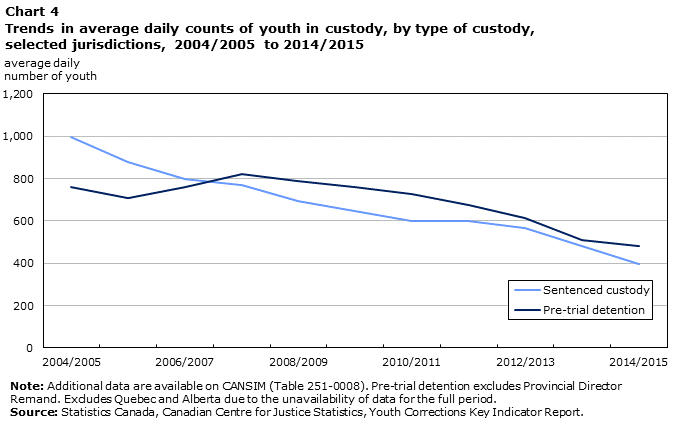
The gap between the number of Canadian youth in pre-trial detention versus those in sentenced custody has once again begun to widen.
 Youth in remand custody on an average day has outnumbered youth in sentenced custody since 2007/2008, said a Statistics Canada report released Jan. 10. While the gap narrowed after 2010/2011, is has increased again in 2014/2015 to 1.21 youth in remand for every one in sentenced custody. On an average day in 2014/2015, 56 per cent of 1009 people age 12-17 were in pre-trial detention and 44 per cent were in sentenced custody.
Youth in remand custody on an average day has outnumbered youth in sentenced custody since 2007/2008, said a Statistics Canada report released Jan. 10. While the gap narrowed after 2010/2011, is has increased again in 2014/2015 to 1.21 youth in remand for every one in sentenced custody. On an average day in 2014/2015, 56 per cent of 1009 people age 12-17 were in pre-trial detention and 44 per cent were in sentenced custody.
“Certainly we are concerned about the fact that the numbers are higher for remand custody than for an actual custodial sentence,” says Samira Mobina Ahmed, litigation lawyer at Justice for Children and Youth in Toronto, adding however that the gap looks pretty narrow.
“That’s an indication that judges are using the right factors as outlined in the Youth Criminal Justice Act for when detention can be used — as a measure of last resort, so it should be that there is a small discrepancy.”
The study, titled Trends In The Use of Remand in Canada, 2004/2005 to 2014/2015, documents the results of four surveys — the Corrections Key Indicator Report for Adults and Youth, the Adult Correctional Services Survey, the Youth Custody and Community Services Survey and the Integrated correctional Services Survey — when it comes to use of remand in Canada. The first survey offered average counts data while the remaining three were used for data on admissions. The analysis doesn’t include federal correctional service data, as it does not supervise remand, or people held in ‘temporary” detention such as immigration holds.
The Criminal Code allows for detention prior to a finding of guilt “to ensure attendance in court; for the protection and safety of the public, including any victims of or witness to the offence; and to maintain public confidence in the justice system,” says the report.
While the number of youth arrested and sentenced overall, as reported by 12 provinces and territories, has declined over the years — with remand count in 2014/2015 down 33 per cent from 10 years ago and the number of youth in sentenced custody made an even larger drop of 60 per cent — this is chalked up to a drop in young people entering the system at all. The number of young people charged with a crime fell 46 per cent nation-wide, but statistically, of those arrested, time spent by youth in pre-trial detention did not change that much over the same time period.
“The numbers are on the decline, which is a good thing. Hopefully this is a reflection of the appropriate application of the YCJA,” says Ahmed. “The sentencing principles allow for there to be lots of discretion on the part of the judge to determine what the appropriate sentence is. Specifically for pre-trial detention, it shouldn’t be used as a substitute for mental health, social or child welfare needs and I think that’s still something courts struggle with which could account for any widening in the gap that you see from time to time.”
In 2014/2015, more than 81 per cent of youth released from remand in the nine jurisdictions that reported figures spent one month or less in pre-trial detention, a “proportion unchanged from 10 years earlier.” Over half of those remanded were there for one week or less — up slightly to 56 per cent from 53 per cent in 2004/2005.
In 2014/2015, and in the eight jurisdictions where information was available, Aboriginal youth made up 36 per cent — or more than one-third — of youth admissions to remand custody. This is five times their representation in the general population. In 2004/2005, this percentage was much lower at 21 per cent. Aboriginal young people in sentenced custody was also disproportionally higher.
“Our office is very concerned about the high percentage of aboriginal young people that are before the courts,” Ahmed says, noting she is unable to, based on the data provided, comment on whether this is an indication that the Gladue Principles aren’t properly being applied in the youth criminal justice context but adds “that’s certainly something we would want to make sure was at the forefront of all consideration for youth that were before the youth courts.”
For the adult population, the report doesn’t have any good news. Across the country, provinces and territories saw the adult remand number rise between 2004/2005 and 2014/2015. Nova Scotia, Northwest Territories, Manitoba and Alberta each saw over 100 per cent increases in average daily counts.
In 2014/2015, compared to 10 years earlier, the number of people in remand has grown almost six times more than the number in sentenced custody, increasing 39 per cent over the last decade while the number in sentenced custody increased seven per cent.
One in four of people admitted to remand in 2014/2015 were Aboriginal, with the exception of statistics from Alberta and Prince Edward Island. This is almost eight times greater than the representation of Aboriginals in the overall population. The statistic is also up nine per cent from 2004/2005, when the number stood at 16 per cent.